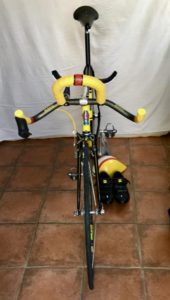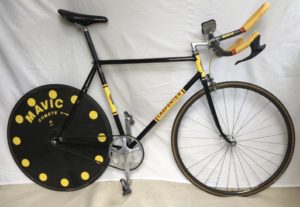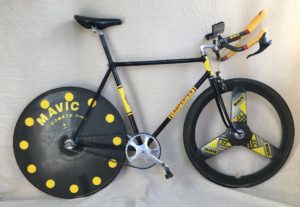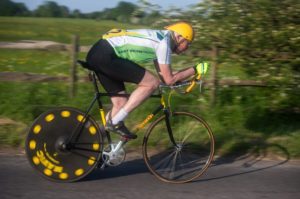Track/ short TT bike
Frame: Reynolds 531, 22″ c-t seat tube, 22.5″ c-c top tube, 11″ bb height, 74/74 head/seat tube angles. Judging by the date, probably built for Carpenter by Colin Cape cycles of Swindon.
‘Tout Mavic’ fixed-wheel groupset unless otherwise stated:
- Mavic 631 ‘Starfish’ single chainset. Early 1990s
- Mavic 610 cartridge bottom bracket.
- Mavic 645 LS Pedals (manufactured by Look, hard anodised). 1987 on.
- Mavic Comete +/- rear disk wheel with screw-on Mavic track adaptor. 1986
- Miche sprocket.
- Unica-Nitor 50 saddle. Late ’60s.
Track Configuration:
T/T road configuration:
- Mavic Mach 2 CD 2 front rim, radially spoked to a Campagnolo Record QR hub. Early 1990s.
- Handlebars: Mavic 355 with Scott aerobars
- Mavic Super-Pro 430 SSC front brake callipers (Modolo manufacture?). Since the photos I’ve changed the lever for a Dia-Compe which is properly designed to plug into the end of the bullhorn
Weight (Track) 20.6 lb/9.5 kg
This bike lies right on the cusp of a revolution in cycle technology. The early ’70s track frame is conventional Reynolds 531. By that date Frank Carpenter’s health was poor, he was out-sourcing his frames, largely to Colin Capes of Swindon. At first it would have been fitted with conventional components. The components on it here reveal much of what happened over the 20 or so years of this bike’s competitive life:-
Mavic were determinedly expanding their product range. The Mavic groupset is mid ’80s to early ’90s, a period when much closer attention was being made to ‘aero’ efficiency. Carbon fibre disk wheels helped a lot – they eliminated all those spokes whirling around – while still being light enough and stiff. All these components were still designed for fitting to steel frames. Then in 1992 Chris Boardman’s 1992 Lotus, with its aero-efficient monocoque carbon-fibre frame, kick-started the change from all that. The demand for steel framed race bikes went into a rapid decline, the future lay with new materials . Manufacturers in the Far East like Giant snapped up Burrow’s innovations, invested a fortune in molds, applied mass-production disciplines (like drastically limiting the range of frame geometries on offer), took advantage of low labour costs. To add to the pressures, those big frame manufacturers were mastering the use of aluminium alloys and titanium in their frames too. “Bye bye Reynolds, the choice of the peloton from Bahamontes to Indurain”. And so, “Bye bye” to the army of artisan frame builders in Britain and Europe.
- The pro peloton had been using carbon disk wheels and ‘bullhorn’ bars since Moser’s hour records. Aerobars were developed for Scott by Boone Lennon and Charley French. Based on Lennon’s wind-tunel testing of the USA downhill ski team they were initially know as ‘ski-bars’. First taken up by tri-athletes, they significantly improved bike split-times and became known as ‘tri-bars’. Then Lenon persuaded Greg LeMond to use them on the last day time-trial of the 1989 Tour de France. It was supposed to be a ceremonial crowning of the French hero Laurent Fignon, no mean ‘tester’ himself. Instead LeMond handed out a massive 58-second beating in just 24.5 km; in so doing he claimed the Tour by just 8 seconds. Eyebrows shot up. The pro peloton promptly adopted these bars for time trials and they became dubbed ‘Aerobars’.
- The front wheel options are a 28 radially spoked Mavic Mach 2 CD 2 hard-anodised rim for road use with a brake (1990ish), or else a 1992 Mavic 3G trispoke wheel for track use.
- The rear wheel was among the first components to be commercially available in carbon fibre. This 1986 Mavic Comete +/- has 12 pockets around the rim where weights could be inserted to add up to a total 780 grams, in the misguided belief the extra angular momentum would lead to a steadier ride (as if the rider’s body weight didn’t provide momentum enough!). Unfortunately this was the wheel used by Greg LeMond in his 1989 TdF TT win so it enjoyed a brief spell of unjustified interest. After a couple of years the idea of weighting the wheel was dropped.
- The Mavic fixed-sprocket adaptor for this disc wheel just screws onto the hub’s conventional freewheel threadings. I have two issues with this. Firstly, the fixed sprocket is necessarily quite a way out from the wheel centre. Secondly, while the sprocket is secured to the adaptor by the usual reverse-threaded lock ring, there is nothing locking the adaptor to the hub. Rear wheel ‘braking’ is done with trepidation and a good dollop of Locktite.
- The 1987 Mavic 645 LS pedals and 430 SSC brake calipers have been bought-in from Look and Modolo respectively, hard-anodised and branded Mavic. This particular bike now has a Dia-Compe brake lever.
- In track configuration the bike is fitted with 1986 hard-anodised Mavic 355 ‘Bullhorn’ bars and 357 aerobars as famously used by Greg Lemond in 1989.
- The Mavic ‘Starfish’ chainset was a very successful component – bolting the ring(s) from the back presented a fashionably ‘aero’ appearance to the outside. This one has been fitted with 7mm stand-off spacers to allow for the removal of the inner ring. Not so ‘aero’ on the inside, then.
- Chater-Lea, Brampton and others sold cartridge bottom brackets before WW2 to repair stripped-out frame shells. Mavic re-introduced the idea to allow precise factory pre-assembly. The first, Mavic 600 version screwed into the BB threads. It used conventional clamping rings which didn’t hold reliably. The second version Mavic 610 fitted here was ‘fully floating’. It didn’t use the BB shell threads at all, there was no longer any need to worry about differing national shell size/threading conventions. Lock rings at both sides with a tapered face held the assembly firm in the frame and centred it, but the frame bottom bracket shell face had to be correspondingly tapered. Not rocket science but terminal if inaccurately done. This particular bike is for track use and short distance TTs; rather than reface the frame shell, I have fitted the clamping rings tapered profile outwards, flat face in. No problems encountered – yet. The 114mm BB spindle leads to quite a gap between chainring and fork, but that’s needed anyway to get a reasonable chain line to the rear sprocket on its adaptor.
- The Miche rear sprocket is neat – no need to unscrew the sprocket body from the hub to change gearing – just remove the lock ring and the toothed ring slides straight off dogs on the sprocket body. I have no idea when this was introduced, it may be a recent innovation for the fixie brigade. Miche is the brand of the Italian ‘Michelin’ company (NOT to be confused with the French tyre makers).
- Nitor introduced the lightweight nylon plastic saddle in the early 1960s. The business was purchased by Unica, then the Unica-Nitor brand bought by Cinelli. These saddles were light but hard, especially on longer rides. Tom Simpson added comfort by covering his with foam and thin leather. He started adapting saddles for other pros. Continental manufacturers noticed. “Bye bye Brooks”.



 1-6-2021 Evening ‘Ten’
1-6-2021 Evening ‘Ten’